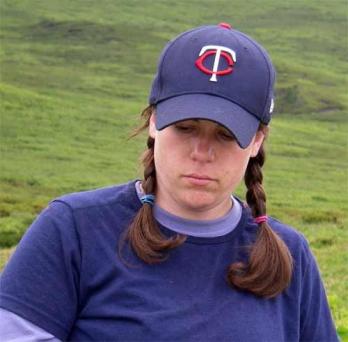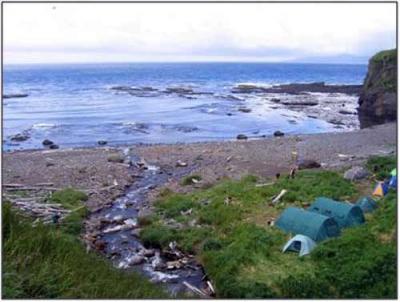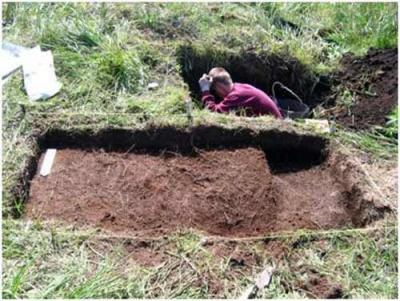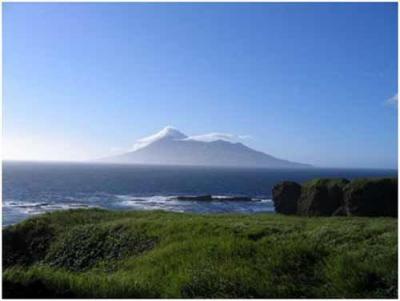The following Journal describing the archaeological activities at the Drobnyye excavation site on Shiashkotan Island has been generously contributed by Shelby Anderson. All photos are courtesy of Shelby Anderson.
 Shelby Anderson
Shelby Anderson
Shelby Anderson
August 2 to August 7, 2007 – Drobnyye, Shiashkotan Island
We arrived at Drobnyye, our second excavation site, mid-morning on August 2nd. The tide was out so unloading all of our gear on the kelp-covered rocky beach was a bit tricky, but also fun as we watched the harbor seals and red fox that were curiously eyeing us from both the shore and the sea. Our camp and excavation site is located on Shiashkotan Island near a freshwater stream that drains into the Okhotsk Sea. The stream made camping convenient for us and was likely one of the things that attracted people to this site in the past. In front of the site is a rocky beach and intertidal zone that is clearly great seal habitat as there were many hanging around in the water and on the rocks for the duration of our stay. Our campsite was situated on a low terrace about 5 meters above the high tide line and we put the semi-portable outhouse that had been relocated from Vodapadnaya, right on the beach! Behind our camp is a steep cliff that leads up to the 15 meter high terrace where parts of the site are located both to the north and south of our camp. The hike up to the site was a little steep every day, but the view was beautiful. On clear days we could see Kharimkotan and Chirinkotan Islands to the north and Matua to the south. The cliffs themselves were created by layers of separate lava flows from long ago volcanic activity. The cliffs are riddled with sea caves that we had only a little time to explore (more about the caves later in Mike Etnier’s Drobnyye Journal) and there is a partial sperm whale skeleton on the beach that has moved very little since the KBP team visited the site last year.
 The Drobnyye camp as viewed from the excavation site on top of a 15-meter terrace. (Photo courtesy of Shelby Anderson)
The Drobnyye camp as viewed from the excavation site on top of a 15-meter terrace. (Photo courtesy of Shelby Anderson)
The Drobnyye camp as viewed from the excavation site on top of a 15-meter terrace.
Based on what we learned about the Drobnyye site from two 1x1 meter test units that were excavated here last summer, our goals were to sample the different time periods represented at the site, to obtain larger faunal and lithic samples, and to better understand the duration and nature of the site occupation as a whole. Radiocarbon dates from the 2006 test excavations yielded both Okhotsk and Epi-Jomon dates, with the earliest radiocarbon date of 750 ± 30 years before present and the oldest of 2130 ± 35 years before present. Historic information suggests that there may have been an Ainu presence at the site as well although this has not yet been documented; there are reports that there was an Ainu village at the north end of Shiashkotan in the 17th or 18th century that was destroyed by the eruption/landslide of the Sinarka volcano, which is located on the northern end of Shiashkotan. In addition, while we suspect that the site was impacted by military activities dating to 1944-45, the nature and extent of this impact was not fully explored in 2006 due to time constraints.
Two strategies were used to gather the data we need to address our research goals. First, we set up several excavation units in different areas of the site. Natasha Toropova and Volodya Golubtsov excavated a 1 by 2 meter unit at the south end of the site near what we thought was an Okhotsk period house, while Dima Shubin, Nick Shankle and I set up a 1 by 2 meter excavation unit next to a test pit that was excavated in 2006 which yielded both Okhotsk and Epi-Jomon dates. We started by re-excavating last year’s test unit so that we could see the stratigraphy before we started the new excavation. Ben Fitzhugh and Taku Osaka excavated a small 1 by 1 meter unit near a possible Ainu house feature located at the north end of the site, which had a trench or moat excavated around it.
 Dima Shubin re-excavating one of the Test Pit units from 2006. The new excavation has been started in the foreground. (Photo courtesy of Shelby Anderson)
Dima Shubin re-excavating one of the Test Pit units from 2006. The new excavation has been started in the foreground. (Photo courtesy of Shelby Anderson)
*Dima Shubin re-excavating one of the Test Pit units from 2006. The new excavation has been started in the foreground. *
The preservation in Natasha and Volodya’s unit was better than in my unit – they found several shell deposits within their unit, including one made entirely of gastropods (snails) and a second consisting primarily of sea urchin shell. Despite the rocky nature of the beach below, the inter-tidal life appeared sparse to those of us who wandered the beach during our stay at Drobnyye. The one creature that abounding today in the tide pools are gastropods that adhere to the rocks; perhaps this was the case in the past as well. Natasha and Volodya also found sea mammal remains, possibly from sea lions, and other faunal material that they collected for analysis this winter at the University of Washington.
In the unit that I excavated with the help of Colby Phillips, Nick Shankle, Dani Plante, and Dima Shubin, we found only decomposing or calcined bone (the result of incompletely burning bones), but also a lot of lithics, including obsidian that Colby will be using for his PhD dissertation, as well as Okhotsk and Epi-Jomon pottery. According to Taku, some of the Epi-Jomon pottery has unusual designs, very different from the Epi-Jomon pottery that he has analyzed in Hokkaido. But this is probably to be expected, considering how far Shiashkotan is from Hokkaido.
We also identified a pit feature in the profile of the 2006 test pit that may actually be an older house feature underneath quite a bit of fill material. We excavated this unit to over a meter deep and uncovered the pit or house floor and a possible hearth feature slightly above this surface. It will be exciting to compare the dates from this possible "living surface” to the dates from the upper part of the excavation, and to better understand how long this part of the site was occupied.
Ben and Taku did not find any artifacts that would help to clarify the age of the house feature that they were digging near. All of the pottery from the unit was non-diagnostic, meaning that they found no characteristics in the pottery that would link them to either Ainu or other time periods, like those that we found in our other excavation units at Drobnyye. So the possible Ainu presence at this site is still unconfirmed by the artifacts alone and we must await the results of radiocarbon dating of charcoal samples from this excavation.
Our second strategy for gathering data was to sample all of the features at the site with the soil probe and to map them. It took two days to soil sample all of the known and a few new features at the site. We found that there are over 40 prehistoric features at the site. Colby, Dani, Nick and I worked in teams of two and used a long soil probe to sample the features, collecting samples when charcoal was present. We also marked the feature locations using a GPS and sketched the shape of each feature using a measuring tape and compass. Feature size is the most helpful in this region for indicating age as Okhotsk houses tend to be much larger than Epi-Jomon houses.
We found that many of the features had been modified by the military in 1944-45, with trenches added to the outside and between house features. House features were also deepened or extended for military use and many of these were likely used as gun emplacements. Because the grass growing across much of the site was very tall, we often found the trenches by falling into them. Nick and I also spent part of an afternoon surveying terraces to the north of the known site area. We found two additional water sources and about 8 to 10 depressions, about 5 of which had charcoal in them. The rest are likely military in origin as no charcoal or artifacts were found using the soil probe.
 Ekarma volcano, at 1170 meters, rises above the sea on Ekarma Island, west of Shiashkotan and the Drobnyye excavation site. (Photo courtesy of Shelby Anderson)
Ekarma volcano, at 1170 meters, rises above the sea on Ekarma Island, west of Shiashkotan and the Drobnyye excavation site. (Photo courtesy of Shelby Anderson)
Ekarma volcano, at 1170 meters, rises above the sea on Ekarma Island, west of Shiashkotan and the Drobnyye excavation site.
After five days of work at Drobnyye, Iskatel arrived to pick us up on August 7. Our next stop – back to Matua to pick up Misty and the tsunami geologists.
Shelby Anderson

